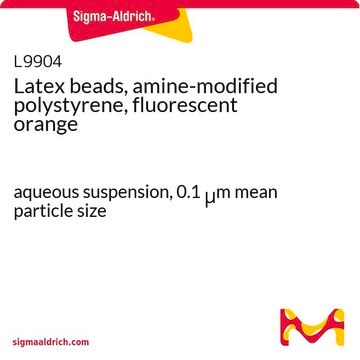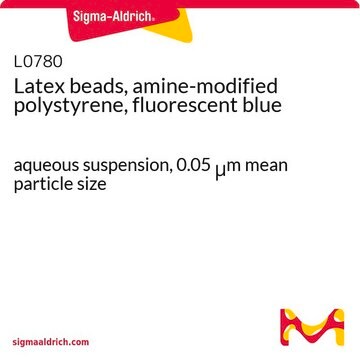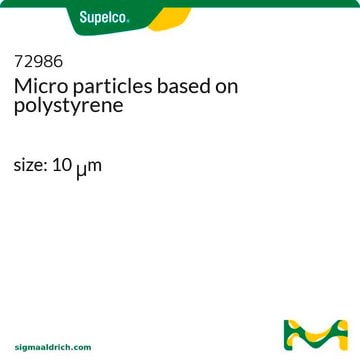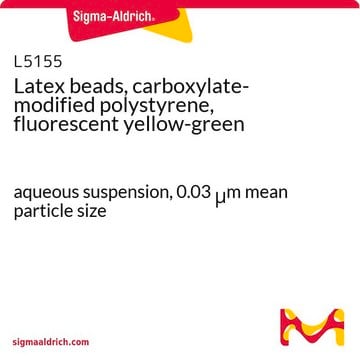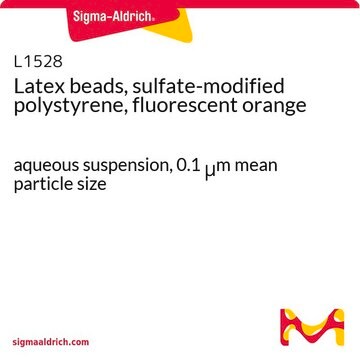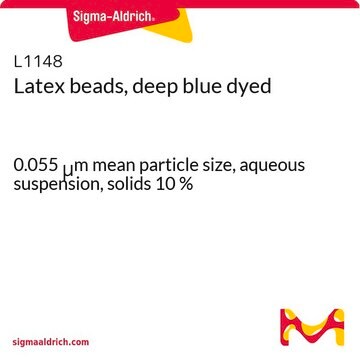LB1
Latex beads, polystyrene
0.1 μm mean particle size
Synonyme(s) :
Latex Beads, Latex Microspheres
Se connecterpour consulter vos tarifs contractuels et ceux de votre entreprise/organisme
About This Item
Produits recommandés
Forme
aqueous suspension
Composition
Solids, 10%
Conditionnement
pack of 1 ea
Taille moyenne des particules
0.1 μm
Vous recherchez des produits similaires ? Visite Guide de comparaison des produits
Description générale
Polystyrene microparticles are anionic-stabilizedcolloidal particles. These microparticles are synthesized by the polymerizationof styrene under conditions that produce coalescent bead formation. Polystyrenelatex beads have a wide range of applications including phagocytosis experiments,antibody-mediated agglutination diagnostics, electron microscopy, and cellcounter calibration.
Application
Polystyrene latex beads have been used:
- inthe flow cytometric assay of endothelial microparticles (EMPs)
- in thedetection of capsular polysaccharide (CPS) antibody/antigen latex agglutinationtest
- to evaluate the phagocytic activity in hemocytes of shrimps
Code de la classe de stockage
10 - Combustible liquids
Classe de danger pour l'eau (WGK)
WGK 3
Point d'éclair (°F)
Not applicable
Point d'éclair (°C)
Not applicable
Faites votre choix parmi les versions les plus récentes :
Déjà en possession de ce produit ?
Retrouvez la documentation relative aux produits que vous avez récemment achetés dans la Bibliothèque de documents.
Les clients ont également consulté
Evaluation of Cellular Absorption and Metabolism of ??Carotene Loaded in Nanocarriers after In Vitro Digestion
Ling C, et al.
Journal of Agricultural and Food Chemistry, 9383-9394, 69-69 (2021)
Francesca Capetti et al.
Journal of separation science, 43(9-10), 1879-1889 (2020-02-20)
The frankincense resins, secreted from Boswellia species, are an uncommon example of a natural raw material where every class of terpenoids is present in similar proportions. Diterpenoids (serratol, incensole, and incensole acetate) are used to discriminate samples from different species
Steven Mascrez et al.
Analytica chimica acta, 1103, 106-114 (2020-02-23)
Headspace solid-phase microextraction (HS-SPME) is an easy, effective, and selective technique for the extraction of volatiles and semi-volatiles compounds. For the latter, longer equilibration times are needed, which are typically shortened by applying agitation or heating the sample. A less
The effect of MWCNTs on molar mass in in situ polymerization of styrene and methyl methacrylate
Annala M, et al.
European Polymer Journal, 48(9), 1516-1524 (2012)
Joanna Koziel et al.
PloS one, 4(4), e5210-e5210 (2009-04-22)
It is becoming increasingly apparent that Staphylococcus aureus are able to survive engulfment by macrophages, and that the intracellular environment of these host cells, which is essential to innate host defenses against invading microorganisms, may in fact provide a refuge
Notre équipe de scientifiques dispose d'une expérience dans tous les secteurs de la recherche, notamment en sciences de la vie, science des matériaux, synthèse chimique, chromatographie, analyse et dans de nombreux autres domaines..
Contacter notre Service technique
